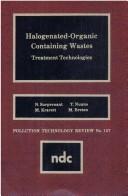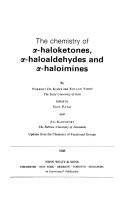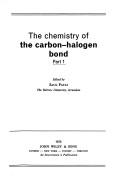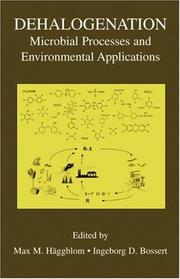| Listing 1 - 8 of 8 |
Sort by
|
Book
ISBN: 0080298265 Year: 1984 Volume: Section 113 Publisher: Oxford New York Toronto Pergamon Press
Abstract | Keywords | Export | Availability | Bookmark
 Loading...
Loading...Choose an application
- Reference Manager
- EndNote
- RefWorks (Direct export to RefWorks)
Hydrocarbons, Halogenated --- Insecticides --- Aromatic compounds --- -Insecticides --- -Organohalogen compounds --- -Halogen organic compounds --- Halogenated organic compounds --- Halogen compounds --- Organic compounds --- Pesticides --- Arenes --- Organic cyclic compounds --- toxicity --- Toxicology --- Metabolism --- -toxicity --- Organohalogen compounds --- Toxicology. --- Metabolism. --- Insekticiden (Giftige). --- Insekticiden. Metabolisme. --- Organohalogeenverbindingen. Toxicologie. --- Aromatiques (Substances). Toxicologie. --- Insecticides. Toxicologie. --- Insecticides. Métabolisme. --- Organohalogénés (Composés). Toxicologie. --- Aromatische verbindingen. Toxicologie. --- Halogen organic compounds --- Wildlife, Effect of insecticides on
Book
ISBN: 0080179037 Year: 1975 Publisher: Oxford : Pergamon,
Abstract | Keywords | Export | Availability | Bookmark
 Loading...
Loading...Choose an application
- Reference Manager
- EndNote
- RefWorks (Direct export to RefWorks)
543.8 --- 547.22 --- Organohalogen compounds --- -Halogen organic compounds --- Halogenated organic compounds --- Halogen compounds --- Organic compounds --- Analysis of organic substances --- Monohalogeno derivatives of saturated hydrocarbons --- Analysis --- Analysis. --- -Analysis of organic substances --- 547.22 Monohalogeno derivatives of saturated hydrocarbons --- 543.8 Analysis of organic substances --- -547.22 Monohalogeno derivatives of saturated hydrocarbons --- Halogen organic compounds --- Halogen compounds. --- Organic compounds.

ISBN: 0815511787 Year: 1988 Volume: vol 157 Publisher: Park Ridge Noyes
Abstract | Keywords | Export | Availability | Bookmark
 Loading...
Loading...Choose an application
- Reference Manager
- EndNote
- RefWorks (Direct export to RefWorks)
Organic wastes --- Organohalogen compounds --- Halogen organic compounds --- Halogenated organic compounds --- Halogen compounds --- Organic compounds --- Garbage --- Wastes, Organic --- Factory and trade waste --- Refuse and refuse disposal --- Sewage --- Waste products --- Handbooks, manuals, etc --- Handbooks, manuals, etc.

ISBN: 0471917087 Year: 1988 Publisher: Chichester : Wiley,
Abstract | Keywords | Export | Availability | Bookmark
 Loading...
Loading...Choose an application
- Reference Manager
- EndNote
- RefWorks (Direct export to RefWorks)
Ketones --- Imines --- Organohalogen compounds --- Cétones --- Composés organohalogènes --- Halogen organic compounds --- Halogenated organic compounds --- Halogen compounds --- Organic compounds --- Diketones --- Oxo compounds --- Ketoacidosis --- Ketonuria --- Organonitrogen compounds --- Imines. --- Ketones. --- Organohalogen compounds. --- Cétones --- Composés organohalogènes

ISBN: 0471669431 9780471669432 Year: 1973 Publisher: London ; New York : John Wiley & Sons,
Abstract | Keywords | Export | Availability | Bookmark
 Loading...
Loading...Choose an application
- Reference Manager
- EndNote
- RefWorks (Direct export to RefWorks)
Organohalogen compounds --- Composés organohalogènes --- 547.12 --- Halogen organic compounds --- Halogenated organic compounds --- Halogen compounds --- Organic compounds --- Carbon bonds. Arrangement of carbon atoms in the molecule --- Organohalogen compounds. --- Basic Sciences. Chemistry --- Organic Chemistry --- Organic Chemistry. --- 547.12 Carbon bonds. Arrangement of carbon atoms in the molecule --- Composés organohalogènes --- Halogen compounds. --- Organic compounds.
Book
ISBN: 321199324X 3211993223 1282509330 9786612509339 3211993231 Year: 2010 Publisher: Wien ; New York : Springer,
Abstract | Keywords | Export | Availability | Bookmark
 Loading...
Loading...Choose an application
- Reference Manager
- EndNote
- RefWorks (Direct export to RefWorks)
Despite the long association of organohalogen compounds with human activities, nature is the producer of nearly 5,000 halogen-containing chemicals. Once dismissed as accidents of nature or isolation artifacts, organohalogen compounds represent an important and ever growing class of natural products, in many cases exhibiting exceptional biological activity. Since the last comprehensive review in 1996 (Vol. 68, this series), there have been discovered an additional 2,500 organochlorine, organobromine, and other organohalogen compounds. These natural organohalogens are biosynthesized by bacteria, fungi, lichen, plants, marine organisms of all types, insects, and higher animals including humans. These compounds are also formed abiogenically, as in volcanoes, forest fires, and other geothermal events.In some instances, natural organohalogens are precisely the same chemicals that man synthesizes for industrial use, and some of the quantities of these natural chemicals far exceed the quantities emitted by man.
Environmental toxicology. --- Halogen compounds. --- Organohalogen compounds. --- Persistent pollutants. --- Organohalogen compounds --- Heterocyclic Compounds, 1-Ring --- Dioxins --- Heterocyclic Compounds --- Chemicals and Drugs --- Civil & Environmental Engineering --- Chemistry --- Environmental Engineering --- Biochemistry --- Physical Sciences & Mathematics --- Engineering & Applied Sciences --- Biodegradation. --- Biocorrosion --- Biodecay --- Biodecomposition --- Biodeterioration --- Biological corrosion --- Biological decay --- Biological decomposition --- Biological degradation --- Decay, Biological --- Decomposition (Biology) --- Degradation, Biological --- Halogen organic compounds --- Halogenated organic compounds --- Chemistry. --- Pharmacy. --- Organic chemistry. --- Organic Chemistry. --- Decomposition (Chemistry) --- Microbiology --- Halogen compounds --- Organic compounds --- Chemistry, Organic. --- Medicine --- Drugs --- Materia medica --- Pharmacology --- Organic chemistry
Periodical
ISSN: 23720611 Year: 1991 Publisher: [Gaithersburg, Md.] : National Institute of Standards and Technology, Building and Fire Research Laboratory
Abstract | Keywords | Export | Availability | Bookmark
 Loading...
Loading...Choose an application
- Reference Manager
- EndNote
- RefWorks (Direct export to RefWorks)
Fire extinguishing agents --- Fire extinction --- Bromotrifluoromethane --- Organohalogen compounds --- Fire prevention --- Agents d'extinction --- Incendies --- Bromotrifluorométhane --- Composés organohalogénés --- Bromotrifluoromethane. --- Fire extinction. --- Fire extinguishing agents. --- Fire prevention. --- Environmental aspects --- Extinction --- Aspect de l'environnement --- Prévention --- Environmental aspects. --- Buildings --- Fire safety --- Fires --- Prevention of fires --- Fire protection engineering --- Public safety --- Insurance engineering --- Chemicals --- Fire extinguishers --- Extinction of fires --- Fighting of fires --- Fire fighting --- Fire suppression --- Firefighting --- Halon 1301 --- Trifluorobromomethane --- Methane --- Halogen organic compounds --- Halogenated organic compounds --- Halogen compounds --- Organic compounds --- Fires and fire prevention --- Prevention --- Chemical systems

ISBN: 0306480115 1402074069 Year: 2003 Publisher: Boston, Massachusetts : Kluwer Academic Pub.,
Abstract | Keywords | Export | Availability | Bookmark
 Loading...
Loading...Choose an application
- Reference Manager
- EndNote
- RefWorks (Direct export to RefWorks)
Halogenated organic compounds constitute one of the largest groups of environmental chemicals. The industrial production of new halogenated organic compounds has increased throughout the last century peaking in the 1960s, and continuing in widespread use today. Organohalides are integral to a variety of industrial applications, including use as solvents, degreasing agents, biocides, pharmaceuticals, plasticizers, hydraulic and heat transfer fluids, and intermediates for chemical synthesis, to name a few. It is important to recognize the beneficial aspects of halogenated organic compounds, as well as their potentially deleterious impact on the environment and health. Recognition of the adverse environmental effects of many types of organohalide compounds has led to efforts to reduce or eliminate the most problematic ones. Although organohalide compounds are typically considered to be anthropogenic industrial compounds, they have their counterpart in several thousands of natural biogenic and geogenic organohalides, representing most classes of organic chemicals. Natural sources account for a significant portion of the global organohalogen budget. This volume authored by recognized experts in the field provides a current perspective on how both natural and synthetic organohalides are formed and degraded, and how these processes are incorporated into a global halogen cycle. The focus is on microbial processes, since these play a major role both in the production and degradation, i. e. , cycling of halogenated organic compounds in the environment. This book is organized into five parts. Part I, Introduction, provides a global perspective on the issues of organohalides and their fate in the environment.
Environment. --- Biochemistry. --- Ecotoxicology. --- Environmental engineering. --- Biotechnology. --- Air pollution. --- Atmospheric Protection/Air Quality Control/Air Pollution. --- Environmental Engineering/Biotechnology. --- Biochemistry, general. --- Environment, general. --- 579.6 --- 579.6 Applied microbiology --- Applied microbiology --- Halophilic microorganisms --- Organohalogen compounds --- Halogen organic compounds --- Halogenated organic compounds --- Halogen compounds --- Organic compounds --- Micro-organisms, Halophilic --- Halophilic organisms --- Microorganisms --- Environmental aspects --- Metabolic detoxification --- Metabolism --- Ecotoxicology --- Pollutants --- Pollution --- Environmental health --- Toxicology --- Biological chemistry --- Chemical composition of organisms --- Organisms --- Physiological chemistry --- Biology --- Chemistry --- Medical sciences --- Chemical engineering --- Genetic engineering --- Environmental control --- Environmental effects --- Environmental stresses --- Engineering --- Environmental protection --- Sustainable engineering --- Air --- Air contaminants --- Air pollutants --- Air pollution --- Air pollution control --- Air toxics --- Airborne pollutants --- Atmosphere --- Contaminants, Air --- Control of air pollution --- Pollutants, Air --- Toxics, Air --- Air quality --- Atmospheric deposition --- Composition --- Control --- Halophilic microorganisms. --- Environmental aspects. --- Metabolic detoxification. --- Metabolism.
| Listing 1 - 8 of 8 |
Sort by
|

 Search
Search Feedback
Feedback About UniCat
About UniCat  Help
Help News
News